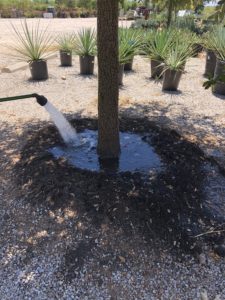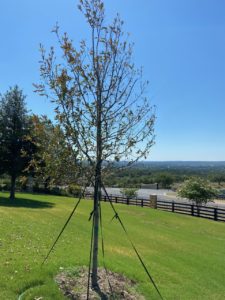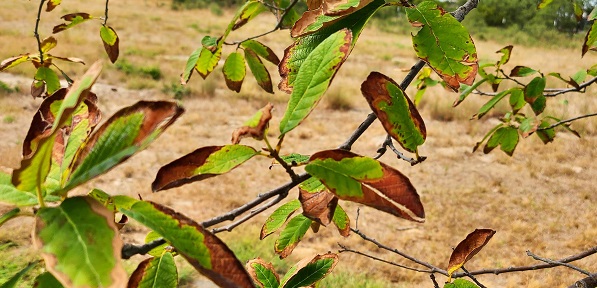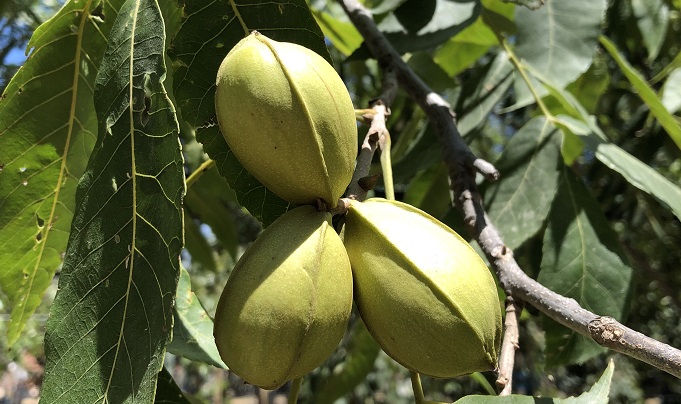Establishing trees in the summer comes with its own set of challenges. Trees CAN be established in the summer, but it is necessary to understand the importance of consistent watering. I have always preferred hand-watering to any form of irrigation, as it requires a “hands on” approach and leaves nothing to chance.
The tree that you bring home has a root system, in a pot, that has been providing water and nutrients for the entire canopy of that tree while being grown in the nursery setting. When you plant the tree in the ground, that does not change. That root system is intrinsically tied to every leaf on that tree. If a root dies, a leaf dies. It’s as simple as that.
Your goal is to maintain that root system and encourage it to root out into the surrounding soil over the next few years. This requires DAILY monitoring of the soil moisture-use your finger and push it down into the soil in the original root ball. If it is dry down to your knuckle, it is time to water it THOROUGHLY.
 THOROUGH watering is quite misunderstood. It means soaking the entire root system that the tree came with all the way to the bottom, plus wetting the soil about a foot out from the root ball. Remember, you are trying to encourage the roots to grow out into the surrounding soil.
THOROUGH watering is quite misunderstood. It means soaking the entire root system that the tree came with all the way to the bottom, plus wetting the soil about a foot out from the root ball. Remember, you are trying to encourage the roots to grow out into the surrounding soil.
Watering in the morning is preferred to watering in the afternoon. Why? Let’s say your tree is watered at the same time every day. If you water in the morning, the tree’s lowest point of moisture will occur during the cool of the nighttime, just before dawn. If you water in the afternoon/early evening, the tree’s lowest point of moisture will occur during the hottest part of the day. Which sounds like the best option for the tree’s health?
Inevitably, it happens. You are in a hurry in the morning, and you can’t stop to water your tree. You will water it when you get home. The temperature is over 100°F and the tree now must go well over 24 hours until it is next watered. Or, you may have planned a short trip and asked a neighbor to water your tree while you are away. But you forgot to tell him how important watering at the same time every day was. When you get home, the tree is crispy.

What happens if you allow the soil to dry to the point of the leaves turning crispy? Is the tree dead, or does it have a chance to come back? I don’t have the answer to that question, but I can help you with what to do next. Sometimes the tree has lost too much of the root system, and nothing you can do will help the tree recover. But there are some things you CAN do, at least if the tree still appears to be viable.
Scratching the twigs may give some indication of whether dieback has begun, but it is not a reliable predictor to the viability of the tree. Only time will tell, and appropriate care in the interim is paramount.
First, DO NOT FERTILIZE a tree that has a compromised root system! We only fertilize healthy trees that are growing well and utilizing nutrients from the soil that need to be replaced. Applying fertilizer to a sick tree could do more harm than good. Any while we are at it, never apply water-soluble fertilizer to dry soil, unless you really want to burn the roots!
Next, remember that the tree now has crispy leaves. They are probably falling off. They are not capable of transpiration, which is the way that the tree releases moisture to the atmosphere. Transpiration is important, because as that moisture is lost, it pulls more moisture from the roots to the top of the tree. If there are no leaves to lose moisture, the root ball will not dry out nearly as fast as it did when the tree had all its leaves, as the roots will not be transporting moisture to the leaves. This means your watering regime will need to be adjusted, and the only way to do this is to check the soil at the root ball EVERY DAY. If you stick your finger into the soil up to your knuckle and it is moist all the way down, you can skip a day of watering. Just don’t forget to check it the next day, and the next.
MOST PEOPLE THINK THAT A TREE THAT HAS DRIED OUT NEEDS EXTRA WATER. DO NOT THINK LIKE MOST PEOPLE. YOU NOW KNOW THAT WATERING WITHOUT CHECKING THE SOIL FIRST CAN BE A DEATH SENTENCE FOR AN ALREADY STRESSED TREE.
Do not allow grass or weeds to grow up to the trunk of the tree. The tree does not need any competition from any other roots! Apply two inches of mulch at least three feet out from the tree, but NEVER let the mulch touch the trunk of the tree.
When will you know if your tree is going to come back or not? That depends on how much of the root system was lost. You may end up losing branches at the top of the tree, or the tips of most of the branches. You may end up losing the tree. There is no way to tell this early in the game, so patience and diligence is key. If you scratch the twigs every couple of weeks, you may get an indication of whether it is continuing to die back, or it is holding steady. A good sign would be if the buds started to swell, and the tree began to leaf out again. If the twigs continue to die back, the chances are not good that your tree will survive.
I hope this helps you understand the changes that occur when a tree loses some or all of its root system to drought. Unfortunately, when a tree is weakened from drought it becomes more susceptible to insect and disease, so it is ever so important to keep your trees as healthy as possible during the establishment process. If you are just in the beginning stages of establishing a tree, please consult our blogs ‘Establishing a tree in the landscape the first year’ and ‘Establishing a tree in the landscape AFTER the first year’.





Thank you so much for all your wonderful emails and sharing your knowledge. My Japanese maple got too much sun with the afternoon temps being so hot here in Belton Texas. The leaves are burned and crispy so I covered the top of the tree with white plant fabric and its been covered about 2 weeks now but air can get to the tree its just the canopy thats covered. My question is should I trim the crispy leaves off when it cools down some tiwards fall. I appreciate all your suggestions.
Hi Charlotte,
Your crispy leaves will fall off on their own eventually. If they are dry and crispy you should be able to run you hand along the branch and they will crumble off. This will keep it from looking unsightly and if you are shading the tree now the dead leaves will not be needed to shade the branch from sunburn, which does happen. I hope that you are considering transplanting the tree in February to a shadier area. I hope the tree does well going forward.
Hi and thanks for sharing all you wonderful knowledge. We have an established Mexican White Oak that has a spot I’d like for someone to look at tell me what it might be/how to treat, if possible. I really don’t want to lose this tree. It’s seems healthy overall. Please let me know. Thanks
Hi Deonna. If you’d like to send a photo for me to look at, please send it to [email protected] I don’t know where you are located, but you can search for a Certified Arborist in Texas here: https://isatexas.com/for-the-public/find-an-arborist/
I’ll be happy to help any way I can.
Mary Kay, I enjoy reading your good advice! Texas gardening is difficult.
I have a sunny 60×90’ garden with pear, plum, peach & apple trees as well as a “u” shaped raised bed for veggies. The sticker grass is overwhelming with all our good rain. I have mowed it with a catcher frequently to remove stickers & dump into a compost. However, so many stay low enough not to cut so it’s an ongoing problem. How can I get rid of it? Also, I have knot nematodes in my raised bed in a few places! What would you do ?
Thank you ! Kay